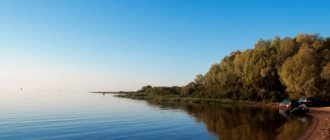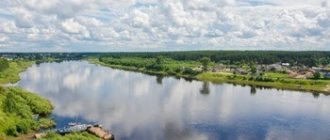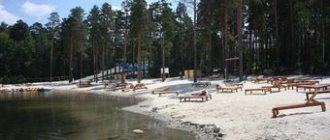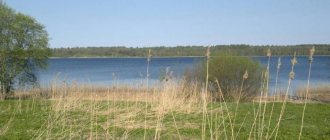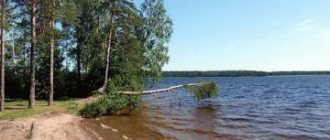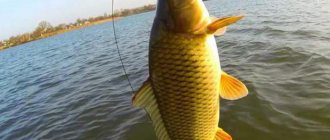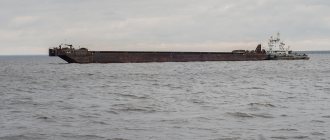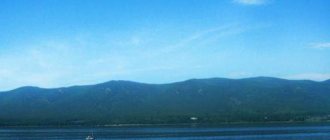Lake name
Lake Ilmen (emphasis on the first I) is a source of myths and legends, for example, some scientists believe that it comes from the Finno-Ugric dialect Ilmeri means “heavenly powers”, while others think that the lake got its name in honor of Ilmera, the sister of the princes of Slovenia and Rusa. Still others talk about the name “Elijah,” which is translated “power of God.” Yu.V. Otkupshchikov noted that the term “ilmen” is found not only in Novgorod, but also in the south, therefore, most likely, it is of Greek origin, as part of the path from the Varangians to the Greeks, and comes from the word “il,” that is, muddy bottom.
Detailed map of Lake Ilmen with names
Before traveling to the lake, it is worth studying a detailed map of the area with all the names. Famous and interesting places and attractions are located on the shores of the lake almost along the entire perimeter, and planning a trip will allow you not to miss a single important point. In addition, the map provides the opportunity to explore routes around the lake and make your trip as convenient as possible.
Geography
When Peter I began to build a bypass canal called Vyshnevolotsky - to supply St. Petersburg with food and other goods from the center of Russia, he noticed that almost fifty rivers flow into the Ilmen reservoir, but only one flows out: the Volkhov. Russian Leonardo Mikhail Vasilyevich Lomonosov laid the foundation for a scientific in-depth study of the Ilmen lowland. As a result of the activities of various expeditions in 1962, the Ilmensky Klint, as the longest formation of the Devonian stage on the East European Plain, became an official natural monument.
Today Lake Ilmen can be considered shallow. It has a flat bottom consisting of a ten-meter thickness of silt. The maximum water depth is 10 meters, and along almost the entire length, that is, about 45 km, you can walk on foot and catch either a fish or a mine from the Second World War. The width in some places is up to 35 km, and the banks are low-lying. There are a lot of deltas in those places where numerous rivers and rivers flow into the Ilmen reservoir. This also determined the occupation of the population: there were many pastures and a lot of arable land.
What makes Lake Ilmen special?
Lake Ilmen is unusual. In Lake Ilmen, the water changes six times a year. The maximum depth of Ilmen at the average water level in our time is no more than 4.5 m, and its area varies widely depending on the fullness of the rivers from 2100 to 610 square km.
The length of modern Ilmen, again at average water levels, is 43 km, and the width is 33 km. The shores of the lake often look unattractive - they are low and swampy, often indented by bays. Along the shore there are solid reeds. Only in the southwest of the village. Korostyn to the village. Oysters along Ilmen stretch for 12 km of reddish limestone rocks - Ilmensky Klint. From a distance they look like the ruins of a fortress, up to 30 m high.
About 96% of the water entering the lake comes from rivers and about 4% from precipitation. On Ilmen there are frequent winds from the South-Western direction. The wave in the middle of the lake reaches a meter, and at its northwestern shore, during northern winds, a surf up to 2 m high occurs.
Therefore, it is dangerous to go to Ilmen on small tourist ships. Moreover, when the weather changes there is nowhere to hide - there are no islands on the lake. The water in the lake does not warm up above 18-20° even in summer.
History of Lake Ilmen
Archaeologists, historians and linguists date the appearance here about 75 thousand years ago, which was associated with the retreat of the glacier. This place was inhabited by Ilmen Slovenes and Russ, whose origin we do not know for sure. It is believed that they lived on the shores of the Baltic. They were neighbors and often attacked Slavic villages. Thus, the Tale of Bygone Years mentions the lake as part of the trade route “from the Varangians to the Greeks,” as well as “from the Varangians to the Persians.” Lake Ilmen was also mentioned in epics, for example, about Sadko, who was also familiar with the sea king, apparently derived from the name of the lake. Even today, unique boats run on the lake - Ilmen soymas. This is a punt with a pair of short masts and a small keel 15–18 meters in length. This is what Sadko used a thousand years ago. Nearby is the city of Novgorod the Great with its centuries-old history, and the city of Volkhov, where today excavations are underway to search for those killed during the Great Patriotic War.
“Fish” Lake Ilmen: what do we know about it?
About the past
As for its rich history, the lake witnesses the beginning of the Cenozoic era - at that time, however, it was tens of times larger. People appeared here about 75 thousand years ago - scientists to this day find traces of their presence in the Ilmen region. Later, representatives of the Scandinavian peoples lived in these areas - researchers believe that they shared the territory with the Slavs.
Ilmen also found its way into ancient chronicles. Thus, in the “Tale of Bygone Years” - one of the main evidence of Russian history - the lake appears as an important point on the legendary trade route “from the Varangians to the Greeks”. It is not surprising that Ilmen was also mentioned in epics, the most famous of which was the cycle about Sadko:
...As Sadko went to Lake Ilmen, // He sat down on a white-flammable stone // And began to play yarovchaty guselki. // How the water in the lake began to shake, // The king of the sea appeared...
Geography and weather
An interesting fact is associated with a popular mistake - the emphasis in the name “Ilmen” is placed on the first syllable, the letter “i”, and not on “e”, as visitors often confuse. In fact, ilmen is a scientific term for small lakes overgrown with reeds and reeds. Novgorod Ilmen cannot be called small; it is one of the largest Russian lakes (45 km long and 35 km wide). The shores go beyond the horizon, so with minimal imagination you can imagine that you are at sea - besides, the lake is famous for its surf, which is atypical for its category.
It is also the only lake in the country whose surface can triple during floods. There are other characteristic features - for example, the wild nature of the local waters. There are no islands on Ilmen, and this factor seriously influences the course of the storm: waves here during bad weather reach two meters, so local fishermen always carefully study the forecast before going out on open water.
Fisherman's happiness
Fishing on Ilmen is an exciting activity. According to reviews from fans of this craft, there is so much fish here that sometimes it’s not even interesting. Among the most popular types of local wildlife are roach, perch, pike, and pike perch.
The shores of Ilmen are often swampy, so if you decide to travel, do not forget to be properly equipped. By the way, there is an amazing place located between the villages of Korosten and Pustosh and which is an eight-kilometer-long cliff - a cliff-ledge, whose height sometimes reaches 15 meters.
Our days
Today Ilmen is a popular tourist destination. Along the shores of the lake there are numerous tourist centers, hotels and campsites, many of which specialize in fishing. However, in addition to fishing, tourists are offered other entertainment - hunting, hiking, trips to local monasteries, villages (for example, there is the village of Golino, whose history dates back to the 13th century) and, of course, the sights of Veliky Novgorod located nearby.
From the tourist reviews we collected on the websites Booking.com and TripAdviser.ru, it follows that holidays on Ilmen are very diverse, but generally budget-friendly - prices for accommodation in a double room start from 780 rubles.
The uniqueness of Lake Ilmen
The reservoir is unusual for its huge size and banks. They are swampy, and also have an 8 km long ledge and a 15 meter cliff between the villages of Korosten and Pustosh, so for the trip you need to be well equipped with ropes and boots. The lake is so huge that it gives the feeling of the sea, you can even hear the sound of the surf. Now Ilmen is a “dying” reservoir due to the impact of geological processes of siltation and the drift of its bed with river sediments.
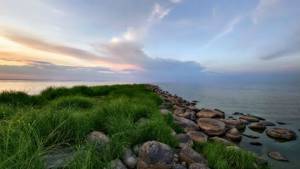
Interesting facts about Lake Ilmen
The features of the unique Russian lake can be listed for quite a long time - many facts are of interest.
- Even in the photo of Lake Ilmen, you can see that the water in the reservoir often becomes yellowish and cloudy, which scares off many tourists. However, in fact, the constantly renewed waters of the lake are very clean - it’s just that the rivers flowing into the reservoir carry a lot of peat and silt, which change the color and transparency of the water.
- Ilmen is a lake dangerous for small shipping. There are practically no islands here, and during storms the waves reach a meter in height, so light river vessels can be wrecked.
- The reservoir is so wide that from one of its banks it is impossible to see the other shore. In bad weather, the reservoir makes a loud and menacing noise, the surf can reach 2 m in height, which is why in the old days the lake was often called the Slovenian Sea, so vast and capricious it seemed to the inhabitants of the shores.
Attention! When visiting Lake Ilmen, it is difficult to imagine that one day it might disappear. However, in fact, the reservoir is at the last stage of its life path, Ilmen is rapidly becoming shallow, its bottom is silting up more and more, and in a few hundred years only a very swampy area will remain in place of the reservoir.
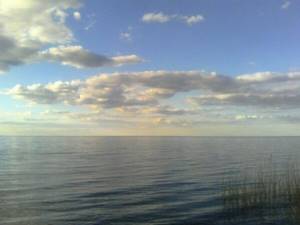
Vegetation, fishing
The lake is home to approximately 40 species of fish: ruffe, asp, bream, tench, burbot, perch, roach, bluegill, smelt, catfish, pike perch, bleak, sabrefish, ide, etc. They say that there is fish everywhere on the lake, a real “golden bottom" for fishermen. Fishing on Ilmen is reminiscent of the film The Diamond Arm, when fishing was always successful, but here there was no need for Anatoly Papanov to hook the fish. According to reviews from residents, there is so much fish here that sometimes it’s not even interesting. Pike are huge, rich in caviar, requiring special art of fishing with live bait. Bacteria living in the lake eat rotten algae, and this digestion process produces flammable gas. Therefore, in winter, fishermen do this: they chop the ice and set fire to the gas coming from the hole. On such a “bonfire” it is quite possible to warm up, boil water, cook fish or bake potatoes in a pot. They say that today there are few such bacteria and the lake is becoming polluted. The forests are home to raccoon dogs, hares, squirrels, martens, foxes, stoats, beavers, muskrats and minks. You can also meet brown bears, lynx, oxen, wild boars, and roe deer. There are also moose, and among the birds there are ducks, geese, wood grouse, black grouse, partridges, woodcock, hazel grouse, snipe, waders, etc. So hunting is also good during the season.
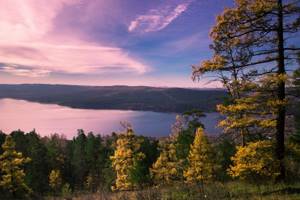
Lake Ilmen in the Volgograd region
The small village of Danilovka, where Lake Ilmen is located in the Volgograd region, is a regional center; 5 thousand people live here. The lake is small, elongated, one kilometer long and 200 meters wide. The outwardly unremarkable body of water enjoys constant success among local residents and fishermen from other areas of the region. There are many small creeks and reed thickets here. This is the place for predators: crucian carp and pike. Like all its namesakes, the lake is shallow, silted and overgrown with reeds. During high water it is invisible among the flood. During the dry season, the water level drops significantly. There are many waterfowl on the lake. Game lives in small forests along the shore, which attracts hunters.
Attractions
Church of the Savior on Nereditsa, Church of St. Nicholas on the Divan, Perynsky Skete, Traveling Palace of Alexander the First, Klopsky Monastery. There is even a rock garden. From here it is convenient to get to Staraya Russa and Veliky Novgorod. Notable are the monuments of the war with the Germans, for example, two monuments to the 19th ski brigade of Yakuts who died on the shore of the lake. There is a legend that the stones around the lake are still red because of the spilled blood. On the shore of this lake, an agreement was signed with Ivan the Third about the end of the Novgorod boyar aristocratic republic.
Where is Lake Ilmen located?
Lake Ilmen on the map of Russia is located in the western part of the Novgorod region, on the Ilmen lowland. The lake rises approximately 18 m above sea level; geographically, the reservoir belongs to the Baltic basin. The largest city in the immediate vicinity is Veliky Novgorod, in addition, the cities of Staraya Russa and Kresttsy are located nearby.
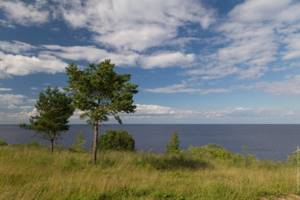
Tourism
Today Ilmen is a popular travel destination. Along the shores of the lake there are tourist centers, campsites and hotels, many of which provide fishing and hunting. For lovers of antiquity, trips to numerous monasteries are organized. For example, here there is the village of Golino of the 13th century and the cultural places of Veliky Novgorod located nearby, famous for the struggle of Alexander Nevsky with the crusaders, the Mikeshin monument to the Millennium of Russia, known to each of us from a school history textbook. Only here does history come to life and you can see with your own eyes the heroic pages of the struggle of the Russian people against foreign invaders in different historical eras. The Lovat and Shelon rivers will tell you about the battle sites; numerous finds and monuments testify to the original Novgorod architectural style.
Renting a house from local residents is a very expensive pleasure, costing 3,000 rubles per day in the village of Korostyn, so not everyone can afford such an exotic experience and prefers camping for 780 rubles per day.
Rest on Lake Ilmen
The picturesque lake is visited by many vacationers, but most try to get here in the summer to swim in this endless lake. The shores of the lake are swampy in many places, reeds grow abundantly along them, so you will have to look for a comfortable place for swimming. You can find both sandy and pebble beaches.
The color of the lake water is yellowish-brown, but this is not due to pollution; this shade occurs due to the presence of peat. The water here is really clean, this is due to its constant and natural renewal thanks to the circulation of water from the rivers flowing into the lake. But there is a drawback to this update - the water in the lake, especially at great depths, can be cool.
Hiking is no less interesting; the nature in the area is truly beautiful. After a walk through the forest, you can pick up mushrooms and berries, which are often very plentiful here. You can also purchase organic products from local residents.

© Vladimir Shalaev
Recreation centers on Lake Ilmen
You can enjoy your holiday in the area at equipped recreation centers. The bases are located not only on the banks of the Ilmen, but also near the rivers flowing into it. Wooden houses are in harmony with the surrounding nature and provide comfort thanks to modern amenities. It will be cozy and pleasant to live in them both in summer and winter. In summer, at some bases you can also stay in a tent. It is possible to either prepare food yourself in the kitchen or barbecue area, or eat in cafes located on the territory of the bases.
Recreation areas offer various types of entertainment - renting boats, fishing, visiting a bathhouse, meeting animals on mini-farms, paintball, laser tag, and rope parks have been created for children at some bases. Excursion tours are also organized that introduce the rich history of Veliky Novgorod and its surroundings, the traditions and crafts of the peoples living in the territory.
In winter, relaxation at the bases is no less exciting; among the active entertainment presented are ice skating, sledding, snowmobiling and ATVs.
© Vladimir Shalaev
Fishing
Fishing enthusiasts will definitely enjoy the lake, because there is such a variety of fish here. In the reservoir there are:
- perch
- ide
- pike
- zander
- bream
- roach.
Before the construction of the Volkhov hydroelectric power station, the lake was inhabited by trout, eel and whitefish.
Wind and high waves often spoil fishing, in addition, sailing far on small boats in bad weather becomes dangerous, so before fishing you should definitely study the weather forecast.
Winter fishing is no less popular; at this time, the main object of fishing is perch.
Ilmen lake in the Novgorod region
Lake Ilmen is a natural attraction of the Novgorod region. The lake amazes with its size and depth. It is so large that in ancient times people considered it a sea. The Slovenian Sea is mentioned in ancient manuscripts. The peculiarity of this reservoir is that its size constantly fluctuates; the lake can shrink three times and increase by the same amount. The coastal part of the lake is indented by channels and islands, of which there are a great many. In some places there are rocky ridges and wetlands.
Where did the name Ilmen come from? There are many versions put forward, and they all have the right to exist. The most popular version is that the name is translated from Ugric as “Heavenly Forces”. This is probably the first thing that comes to mind when seeing these enormous bodies of water for the first time. There is a possibility that the lake was named after the Scythian princess Ilmera. Some adhere to the biblical version, drawing parallels between the name of the lake with the name "Elijah", which is translated as "God's power". The simplest version is that the name of the lake comes from the word “silt”, and, indeed, the bottom of the lake is very muddy.
Lake Ilmen is fed by fifty rivers. The only river that flows out of it connects Ilmen with Ladoga. The lake is especially full in the spring, when meltwater flows into it. In winter, the lake is covered with ice. The lake water contains a large amount of organic substances, in particular peat, which is why the water has a slightly brown tint. Don’t be afraid that the water is dirty; the water in the lake is very clean, because it is completely renewed in two months. The lake is very deep and does not warm up, so even in hot weather the water temperature rarely rises above 20 degrees. In addition, the rich organic matter of the lake contributes to the blooming of water in hot weather, especially in shallow waters.
There are many fishing legends about the fish of Lake Ilmen. The lake abounds in fish. There are more than 50 species of fish here: huge pike and catfish, perch, asp, and pike perch in abundance. Unfortunately, whitefish have disappeared; the construction of the Volkhov hydroelectric power plant is to blame for this. There are a lot of wonderful places for fishing on the lake; even a type of tourism has been developed when people come from far away to fish for the weekend; special fishing tours have been developed. All this provides work to local villages. People sell the fish they catch and rent out housing to tourists. There is a fish procurement plant left over from the times of the USSR, called, as in those days, “Red Fisherman”. They fish on the lake all year round using a variety of fishing gear. Large fish such as pike and catfish are caught with a spinning rod; bream or burbot can be caught with a fishing rod. However, in the fall the lake is very stormy, which is not a good time for fishing. Freeze-up begins in November, the ice remains until April. Winter ice fishing is very developed here.
The fish wealth of the lake is amazing, especially for beginners. The catches are large and very diverse; fishermen are especially pleased and large specimens of fish are a source of pride. There are a lot of legends about the lake. The most famous legend is the tale of Sadko. In the Soviet Union, every schoolchild knew her thanks to the cartoon of the same name. The plot is simple. The sea king liked Sadko's skillful playing of the harp, and he invited him to play in his underwater kingdom. In gratitude for the pleasure he gave, he advised the guslar to bet with the richest people in the city for a large sum of money that he would catch three exotic fish from the lake with nets. And so it happened, as a result of which Sadko became rich and became a merchant himself.
A lesser known, but no less interesting legend is about the brothers Sloven and Ruse. They lived on the shores of the Black Sea, but decided to look for new lands. For a quarter of a century they wandered the earth in search of a suitable place, until they came to the shore of a huge lake, whose waters reminded them of their native land. Here the brothers founded the two cities of Slovensk (now Novgorod) and Rusa (now Staraya Rusa), and named the lakes after their beloved sister Ilmera.
Video fishing on Lake Ilmen in the Novgorod region
Lake Ilmen is a natural monument and is protected by the state. There is a special environmental management regime in effect here; fishing with nets, mining and any work within the coastal zone of the lake is prohibited.
Olga Perminova
